Sovremennyy-class destroyer
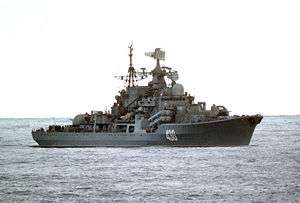 Sovremennyy-class destroyer Bezuprechnyy | |
| Class overview | |
|---|---|
| Name: | Sovremennyy class |
| Builders: | Severnaya Verf (Zhdanov Shipyard) |
| Operators: | |
| Preceded by: |
|
| Succeeded by: |
|
| In commission: | 1980 |
| Completed: | 21 |
| Active: | 5 active, 3 ongoing modernization and 2 in reserve in Russia, 4 active in China |
| Retired: | 10 |
| General characteristics | |
| Type: | Anti-aircraft and anti-ship guided missile destroyer |
| Displacement: | 6,600 tons standard, 8,480 tons full load |
| Length: | 156 m (511 ft 10 in) |
| Beam: | 17.3 m (56 ft 9 in) |
| Draught: | 6.5 m (21 ft 4 in) |
| Propulsion: | 2 shaft steam turbines, 4 boilers, 75,000 kW (100,000 hp), 2 fixed propellers, 2 turbo generators,and 2 diesel generators |
| Speed: | 32.7 knots (60.6 km/h; 37.6 mph) |
| Range: | 14,000 nmi (26,000 km; 16,000 mi) at 14 knots (26 km/h; 16 mph) |
| Complement: | 350 |
| Sensors and processing systems: |
|
| Electronic warfare & decoys: | 2 PK-2 decoy dispensers (200 rockets) |
| Armament: |
|
| Aircraft carried: | 1× Ka-27 'Helix' |
The Sovremennyy-class destroyer is the principal anti-surface warship of the Russian Navy. The Soviet designation for the class was Project 956 Sarych (Buzzard).
The primary role of this guided missile destroyer is to attack enemy warships while also providing sea and air defense for warships and transports under escort. It complements the Udaloy-class destroyers in anti-submarine operations.
History
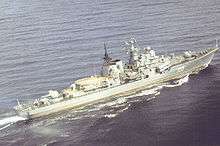
The project began in the late 1960s when it was becoming obvious in the Soviet Navy that naval guns still had an important role particularly in support of amphibious landings, but existing gun cruisers and destroyers were showing their age. A new design was started, employing a new 130 mm automatic gun turret. Single and twin mounts were developed, and the twin mount chosen for its superior rate of fire. In 1971 a go-ahead was given for the Severnaya design bureau to design "a ship capable of supporting amphibious landings".[1] At the same time, the United States Navy was constructing new large Spruance-class multi-role destroyers. To respond to this new threat, Project 956 was updated with new air defence suite and new, powerful 3M80 anti-ship missiles. Although the Soviet Navy had largely moved to gas turbine propulsion for its new warships, steam turbines were selected instead for Project 956: partly because production of naval gas turbines would have been insufficient for entire program. Lead ship of the class, Sovremenny was laid down in 1976 and commissioned in 1980. A total of 18 have been built for the Russian Navy, but currently only 5 remain in service due to lack of funds and trained personnel. Additional 3 ships are ongoing modernization and overhaul and 2 are laid-up in reserve. All the ships were built by Severnaya Verf 190 St. Petersburg.
These ships have a maximum displacement of 7,940 tons. The ships are 156 metres (511 ft 10 in) in length, with a beam of 17.3 metres (56 ft 9 in) and a draught of 6.5 metres (21 ft 4 in). They are armed with an anti-submarine helicopter, 48 air defence missiles, eight anti-ship missiles, torpedoes, mines, long-range guns and a sophisticated electronic warfare system.
There are a total of three versions of this class: the original Project 956 armed with the 3M80 version of the Moskit anti-ship missile, and its successor, the Project 956A, which is armed with the improved 3M80M version of the Moskit anti-ship missile with longer range. The main difference between the two is that the missile launching tubes on Project 956A are longer than that of Project 956 to accommodate the increased size of the newer missile, and these launching tubes can be used to fire / store the original 3M80 as well. A third version, Project 956EM, later developed for the People's Liberation Army Navy Surface Force was the latest development of this class. Chinese media called the ship "carrier killer".
Design
Command and control
The ship's combat systems can use target designation data from the ship's active and passive sensors, from other ships in the fleet, from surveillance aircraft or via a communications link from the ship's helicopter. The multi-channel defence suite is capable of striking several targets simultaneously.
Missiles
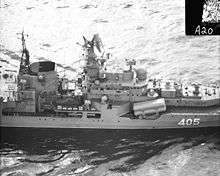
The ship is outfitted with the Raduga Moskit anti-ship missile system with two four-cell launchers installed port and starboard of the forward island and set at an angle about 15°. The ship carries a total of eight Moskit 3M80E missiles, NATO designation SS-N-22 Sunburn. The missile is sea-skimming with a velocity of Mach 2.5, armed with a 300-kilogram (660 lb) high-explosive or a nuclear 200 kt warhead. The range is from 10 to 120 kilometres (6.2 to 74.6 mi). The launch weight is 4,000 kg (8,800 lb).
Two Shtil surface-to-air missile systems are installed, each on the raised deck behind the twin-barrelled 130 mm guns. Shtil is the export name of the SA-N-7, NATO reporting name Gadfly. (From the 9th ship onwards, same launcher is used for SA-17 Grizzly/SA-N-12 Yezh.) The system uses the ship's three-dimensional circular scan radar for target tracking. Up to three missiles can be aimed simultaneously. The range is up to 30 km (19 mi) against targets with speeds up to 830 metres per second (2,700 ft/s). The ship carries 48 Shtil missiles.
Guns

The ship's 130-millimetre (5.1 in) guns are the AK-130-MR-184. The system includes a computer control system with electronic and television sighting. The gun can be operated in fully automatic mode from the radar control system, under autonomous control using the turret mounted Kondensor optical sighting system and can also be laid manually. Rate of fire is disputed, but various Russian sources credit the weapon with a cyclic rate of 30-40 rounds per minute per barrel, in line with the French Creusot-Loire 100 mm or the Italian OTO Melara 127 mm/54, but faster than the US Mark 45.
The ship has four six-barreled 30 mm AK-630 auto-cannon systems. The maximum rate of fire is 5,000 rounds/min. Range is up to 4,000 m for low flying anti-ship missiles and 5,000 m for light surface targets. The gun is outfitted with radar and television detection and tracking. The latest Sovremennys carry the Kashtan CIWS system instead of AK-630.
Anti submarine systems

The destroyer has two double 533 mm (21 in) torpedo tubes and two six-barrel RBU-1000 anti-submarine rocket launchers, with 48 rockets. Range is 1,000 metres (1,100 yd). The rocket is armed with a 55 kg (121 lb) warhead.
Helicopter
The ship's helicopter pad and telescopic hangar accommodates one Kamov Ka-27 anti-submarine warfare helicopter, NATO codename Helix. The helicopter can operate in conditions up to Sea State 5 and up to 200 km (120 mi) from the host ship.
Countermeasures
The Project 956 destroyer is fitted with an electronic countermeasures system and carries a store of 200 rockets for the two decoy dispensers, model PK-2.
Sensors
Radar
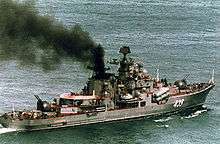
The complete sensor suite and ECM comprises: 3D radar 'Top Steer', replaced later with 'Top Plate' (MR-760), 230 km range vs fighters and 50 km vs missiles and a total of 40 targets can be simultaneously tracked; Mineral system ('Band Stand') to allow the SS-N 22 guidance; 3 navigation and surface control radar MR-201 e 212; 2 'Bass Tilt' (MR-123) for CIWS; 6 'Front Dome'(MR-90) radar for SA-N-7 guidance (a very large arrangement to assure an effective defense against saturation attacks), linked with 3D radar and two SAM launcher (5 missile min each); 1 'Kite Screech' radar for 130 mm (MR-184 Lev). ECM and ESM are many: 2 ESM MR-410 or MP-405; 2 ECM MRP-11M or 12M ('Bell Shroud'), 2 'Bell Squat', 4 'Foot-ball B' and one MR-407; 2 PK-2M rocket launchers (140 mm), and 8 PK-10 (120 mm), 2-8 laser warning receiver systems Spektr-F, one Squeeze Box (TV, laser and IR system).
Sonar
Medium and high frequences (M/HF) MGK-355 Platina integrated sonar system with NATO reporting name Bull Horn, including the MG-335 hull mounted array. Type 956 originally only carries the hull mounted array because the ASW gear of this class is primarily for self-defense. For Type 956A, an improved MGK-355MS Platina is carried, which include hull mounted array, VDS, and towed array, with NATO reporting names Bull Nose / Mare Tail / Steer Hide respectively. It is reported that Type 956EM equipped with the successor of MGK-355/355MS, the MGK-355TA integrated sonar system which includes both the hull mounted and towed arrays (with NATO reporting name Horse Jaw & Horse Tail respectively).
Propulsion
The ship's propulsion system is based on two steam turbine engines each producing 37,000 kW (50,000 hp) together with four high-pressure boilers. There are two fixed-pitch propellers. The ship's maximum speed is just under 33 knots (61 km/h; 38 mph). At a fuel-economic speed of 18 knots (33 km/h; 21 mph) the range is 3,920 nautical miles (7,260 km; 4,510 mi). Several ships of this class suffered from problems regarding their propulsion system that were so severe that they had to be retired.[2]
PLAN variants
The Chinese People's Liberation Army Navy Surface Force (PLAN) had two modified Sovremennyy destroyers delivered in December 1999 and November 2000. In 2002, the PLAN ordered two improved versions designated 956-EM. The first vessel was launched in late 2005, while the second was launched in 2006. All four vessels were commissioned to the East Sea Fleet.
On the improved Project 956EM the aft AK-130 main gun was removed. The four AK-630 CIWS were replaced by two sets of Kashtan CIWS short-range air defence gun/missile systems. Each Kashtan system comprises a 3R86E1 command module and two 3R87E combat modules. Each 3R87E combat module has two 30 mm GSh-30k six-barrel automatic guns (range 0.5–4 km (0.31–2.49 mi)) and two SA-N-11 air defence missiles. The missile is armed with a 9 kg (20 lb) warhead and has a range of 1.5–8 km (0.93–4.97 mi). This improved 956EM version is also the first to be armed with the newer version of SS-N-22, which reported has a designation of 3-M80MBE and possibly funded by China (according to Russian sources), and the new missile differs from the older ones mainly in that the range is increased from 120 km (75 mi) to 200 km (120 mi). The air defense software is upgraded to accommodate the newer SA-N-12/SA-17 SAM system, but since China had already joined Russia in developing an even newer successor, it is not clear if SA-N-12/SA-17 has entered Chinese service in large numbers.
In 2006, the extra spheres (painted white as the mid-2006) added atop of the superstructures of the Chinese ships appearing in latest photographs of the Chinese units have shown that these Chinese ships had been upgraded with the domestic HN-900 Data link (Chinese equivalent of Link 11A/B, to be upgraded) and SATCOM (probably the SNTI-240).
From mid 2014, all four Chinese Sovremennyy-class destroyers are planned to undergo a major refit and modernisation program. Hangzhou is currently undergoing refit with the removal of its original components, and are expected to be replaced with domestic systems.
- Project cost: 600 million US$ (mid-1990s price) was the price paid by China for Project 956A (two ships), and 1.5 Billion US$ (early-2000's price) for Project 956EM (two ships).[3]
-
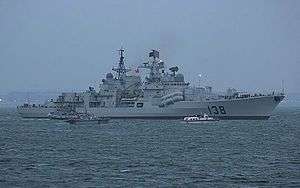
The third Sovremennyy-class destroyer sold to China was delivered in December 2005.
-

The newest version has updated its close-defense systems.
-

The rear main gun has been removed from the latest version.
Ships
_is_currently_underway_participating_in_Baltic_Operations_(BALTOPS)_2005.jpg)

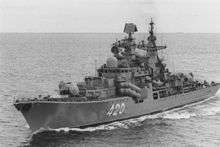
Soviet/Russian navies
- Sovremennyy – Современный – Modern (1980),
decommissioned in 1998, scrapped in 2003 - Otchayannyy – Отчаянный – Reckless (1982),
decommissioned in 1998 - Otlichnyy – Отличный – Excellent (1983),
decommissioned in 1998 - Osmotritelnyy – Осмотрительный – Circumspect (1984),
decommissioned in 1997 - Bezuprechnyy – Безупречный – Impeccable (1985),
decommissioned in 2003 - Boyevoy – Боевой – Militant (1986) –
Out of active service. Modernization and overhaul - Stoykiy – Стойкий – Steadfast (1986),
decommissioned in 1998 - Okrylennyy – Окрылённый – Winged (1987),
decommissioned in 1998, scrapped in 1999 - Burnyy – Бурный – Impetuous (1988)
Out of active service. Ongoing modernization and overhaul - Bystryy (715) – Быстрый -Quick (or Rapid) (30 September 1989) –
In service, Pacific Fleet - Rastoropnyy – Расторопный -Prompt (1989) –
Decommissioned in 2012. Laid up at Kotlin Island, St. Petersburg. Possibility of modernization and return to active service - Bezboyaznennyy – Безбоязненный -Intrepid (or Fearless) (1990) –
Out of active service. Modernization and overhaul - Gremyashchiy (406) – Гремящий – Thunderous (originally Bezuderzhnyy – Безудержный – Impetuous or Unrestrained) (25 June 1991) –
In service, Northern Fleet - Veduschiy – Ведущий – Leading (1988) –
Decommissioned in 2006. Possibility of modernization and return to active service - Bespokoynyy (620) – Беспокойный – Restless (28 December 1991)
In service, Baltic Fleet - Nastoychivyy (610) – Настойчивый – Persistent (originally Moskovskiy Komsomolets – Московский комсомолец) (30 December 1992)
In service, Baltic Fleet - Admiral Ushakov (434) – Адмирал Ушаков – (originally Besstrashnyy – Бесстрашный – Fearless) (30 December 1993)
In service, Northern Fleet
PLA(N)
- Vazhnyy – Важный – Eminent (Hangzhou (136) – 杭州 – sold to China before completion)
- Vdumchivyy – Вдумчивый – Thoughtful (Fuzhou (137) – 福州 – sold to China before completion)
- Taizhou (138) – 泰州 – improved 956EM built for China (2005)
- Ningbo (139) – 宁波 – improved 956EM built for China (2006)
China reportedly also holds the option to purchase an additional two Project 956EM in the future, but this now seems unlikely with the decision to proceed with the 052 series DDG in 2005.
See also
References
- ↑ "956 Sovremenny class | Russian Military Analysis". Warfare.ru. Retrieved 2011-12-28.
- ↑ John Pike (2004-05-06). "Sovremenny Class - Project 956". Globalsecurity.org. Retrieved 2011-12-28.
- ↑ http://www.janes.com/regional_news/asia_pacific/news/jdw/jdw020108_1_n.shtml
http://www.sinodefence.com/navy/surface/sovremenny.asp
External links
| Wikimedia Commons has media related to Sovremennyy class destroyer. |
- http://ship.bsu.by/main.asp?id=100188 – page on these ships in Russian language
- http://home19.inet.tele.dk/airwing/ships/sovremen.htm – article in English
- https://fas.org/man/dod-101/sys/ship/row/rus/956.htm – article in English from FAS
- http://www.sinodefence.com/navy/surface/sovremenny.asp
- (English) All Russian Sovremenny Class Destroyers – Complete Ship List
| ||||||||||||||||||||||||||||||||||||||||||||||||||||||||||